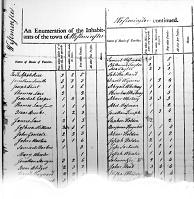The 2010 Census and what property managers need to know
 Monday, March 15, 2010 at 12:00PM
Monday, March 15, 2010 at 12:00PM
 It’s 2010 and a census year! Every ten years, the U.S. Census counts every resident in the United States. It is required by the Constitution to take place every 10 years, without fail.
It’s 2010 and a census year! Every ten years, the U.S. Census counts every resident in the United States. It is required by the Constitution to take place every 10 years, without fail.
The census results tell us who we are, how many of us there are, where we are and how we live. The results tell us about our family structures, our housing types and our gender numbers. Census data determines how essential federal dollars will be allocated amongst communities and provides the data upon which future programs will be justified or denied.
Simply stated, the census data provides the information framework upon which thousands of important decisions are based over the ten year period following the census year. The census is quite simply, the best snapshot of the public American persona we have available to us; and it is important we get the picture right! We all benefit from accurate census information.
Most households, including those in apartment buildings, are by now in receipt of their 2010 Census questionnaire. If interested, you can view a sample of the very short (just ten questions) questionnaire at http://bit.ly/7Imp35.
Responses are due back by April 1, 2010. If a household does not return their completed form by the end of April, census gatherers will begin their visits to unresponsive households. Because of the import of census data, this effort is to get residents who have not responded to complete the form. These follow up visits should take place from approximately May through August 2010.
The visits will include apartment communities and complexes, not just owner occupied housing or single family dwellings. This means apartment owners, as well as off- and on-site managers will likely be contacted by census staff workers who will be asking questions and requesting access to buildings.
What should an owner or manager do when faced with requests for information and access to buildings or communities from census staff?
Step One – Verify
The first thing to do is to verify the identity and authority of the person requesting information about or access to your property. The census “Contact Us” page can be found here: http://2010.census.gov/2010census/contact/index.php. Address and telephone numbers for all of the regional Centers are available on this page.
In our company we verify the identity of everyone, no matter how real the credentials appear. Having such a broad-based verification program is one way to protect yourself and your company from a cleaver scam artist. Given that scams are more prevalent and forgery is easier than ever before, this sort of protection is your best protection.
As part of your verification process, be sure to record your procedure in reasonable detail. Who did you call, on what date and at what number? Who did you speak with and what procedure did you use to authenticate the identity of the census employee at your site? Record or file this information in a location that can be readily found at a later date.
Step Two – Understand the Law
Be ready to respond to census workers by organizing in advance how you plan to provide access to buildings or to share information. Remember, census cooperation is required by law! You cannot avoid cooperating by claiming it is against your company policy or a violation of some local or state law.
Providing access to your community and the sharing of what may feel to be private information can be a sensitive, perhaps even uncomfortable issue. Consequently, you may want to write to your residents in advance and advise them that your cooperation with and release of information to census workers is required by law. Let residents know you will both provide access to the census workers to knock on apartment doors and you will answer questions when asked.
You may want to point out that the best way for residents to avoid having you share information about them, is for the resident to respond to the census questionnaire themselves. If the resident returns the questionnaire, no one from the census will be asking you questions about who resides in their apartment unit!
Step Three – Cooperate and Confirm
When you do cooperate by providing access or answering questions, make sure to record what you did, who made the requests of you, and when the events occurred by confirming the events in your company logs. And, similar to your procedure to verify the identity of the census staffer, record or file the confirmation information in a location that can be readily found at a later date.
Remember good records are your best defense in the event of a claim of inappropriate site access, improper disclosure of information about a resident, or a failure to cooperate made against you by the census program.
It’s best to be prepared in advance, so take the time now to develop your Census Protocol Response Program (CPRC) before the census workers will be contacting you in May. Remember: Verify – Understand the Law – and Cooperate and Confirm.

